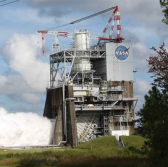 Aerojet Rocketdyne has completed additional tests on a development engine for a NASA launch vehicle at the Stennis Space Center to check the engine’s capacity to withstand a challenging operational environment.
Aerojet Rocketdyne has completed additional tests on a development engine for a NASA launch vehicle at the Stennis Space Center to check the engine’s capacity to withstand a challenging operational environment.
Aerojet Rocketdyne said Thursday the RS-25 engine dubbed 0528 that NASA will use for the Space Launch System ran for 420 seconds on power levels that range from 80 percent to 111 percent.
“Our engine testing at Stennis is moving us closer to powering the journey to Mars and introducing a new era of launch technology,” said Eileen Drake, Aerojet Rocketdyne president and CEO.
The company previously tested engine 0528 in July to check the upgraded controllers’ compliance with SLS requirements.
“In addition to the RS-25 engine testing at Stennis, we also test our RS-68 engine for the Delta IV and the AR1 engine,” Drake added.
Aerojet Rocketdyne noted three RS-25 engines have accumulated 5,468 seconds of test time to date and engine 0528 has recorded 1,263 test seconds.
The company said it also supports the propulsion and power requirements for Orion, solar electric propulsion, deep space habitats, ascent vehicles as well as the entry, descent and landing systems for the Mars mission.
Aerojet Rocketdyne added it has identified 45 potential engine components that it can produce through 3-D printing in support of efforts to reduce the overall engine manufacturing period by 25 percent.




